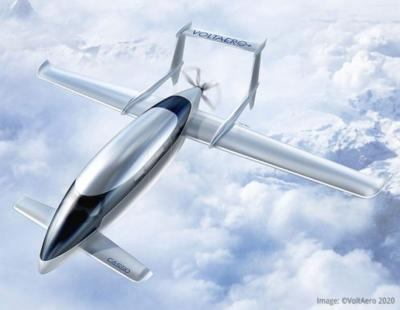Fri, Jul 30, 2021
Codes For Infrastructure To Support The eVTOL Market Are Still In Development
By Rex Alexander
While the future may be all electric, it now may very well be Hybrid-Electric. At least according to CEO Jean Botti VoltAero’s CEO and Chief Technology Officer (pictured).

At this year’s EAA AirVenture, VoltAero introduced their four-seat Cassio 330 – the first Cassio version of the VoltAero’s hybrid-electric aircraft family to enter production. The company believes that their Cassio 330 can be strategically positioned at U.S. airport locations based on user demand. To facilitate this vision, VoltAero has teamed up with KinectAir, a software aviation company focused on regional air mobility, to help facilitate their fractional ownership strategy, which is now available in the U.S. This strategy incorporates the company’s OnDemand flight services to be driven by artificial intelligence while utilizing advanced smartphone applications.
While many in the industry are talking about burgeoning eVTOL (Vertical Takeoff and Landing) market the Cassio 330 is designed to operate in the eCTOL (Conventional Takeoff and Landing) arena. This will allow the aircraft to utilize traditional airport infrastructure that is currently in place today without the need for costly and time-consuming retrofitting. That fact is very important in that standards and codes for infrastructure to support the eVTOL market are still in development and at best a 2-4 years away.

“The Jetsons future of rooftop-to-rooftop travel we see in very promising projects like Joby and Beta is just a long way out. The Cassio brings an efficient and elegant clean-sheet design for an aircraft that can take off and land on the smaller, local airfields we are already operating from. And we expect to bring it to the fleet as early as 2024,” explained KinectAir Chief Executive Officer Jonathan Evans. “This marriage of hybrid electric propulsion in conventional take off and landing aircraft (eCTOL) is the emerging leader for greening regional air travel. We put these aircraft on a network, and we put the power to summon them in your hands, and that’s game changing.”
Building on their validation effort on its hybrid-electric powertrain through flight trials with the company’s Cassio 1 demonstrator aircraft, VoltAero is advancing the Cassio family design phase for the future. Production will begin with the four-seat Cassio 330, featuring a combined hybrid-electric power of 330 kilowatts. Initial Cassio 330 deliveries are targeted for the fourth quarter of 2023, to be followed by the Cassio 480 and the Cassio 600, utilizing hybrid electric propulsion rated at 480 and 600 kilowatts, respectively.
More News
We're Everywhere... Thanks To You! Even with the vast resources and incredibly far-reaching scope of the Aero-News Network, every now and then a story that should be reported on sl>[...]
From 2015 (YouTube Version): Oshkosh Reveals Many Treasures... Including Old Warbirds Full Of History While at EAA AirVenture 2015, ANN News Editor, Tom Patton, ventured out to vis>[...]
"The aircraft achieved the maximum recorded airspeed of 180 Knots IAS at about 08:08:42 UTC and immediately thereafter, the Engine 1 and Engine 2 fuel cutoff switches transitioned >[...]
Temporary Flight Restriction (TFR) A TFR is a regulatory action issued by the FAA via the U.S. NOTAM System, under the authority of United States Code, Title 49. TFRs are issued wi>[...]
Aero Linx: Aviation Without Borders Aviation Without Borders, a leading humanitarian aviation charity, uses its aviation expertise, contacts and partnerships to enable support for >[...]
 ANN FAQ: How Do I Become A News Spy?
ANN FAQ: How Do I Become A News Spy? Classic Aero-TV: The PB4Y-2 Privateer - A Priceless Aero-Treasure
Classic Aero-TV: The PB4Y-2 Privateer - A Priceless Aero-Treasure Aero-News: Quote of the Day (07.14.25)
Aero-News: Quote of the Day (07.14.25) ANN's Daily Aero-Term (07.14.25): Temporary Flight Restriction (TFR)
ANN's Daily Aero-Term (07.14.25): Temporary Flight Restriction (TFR) ANN's Daily Aero-Linx (07.14.25)
ANN's Daily Aero-Linx (07.14.25)




